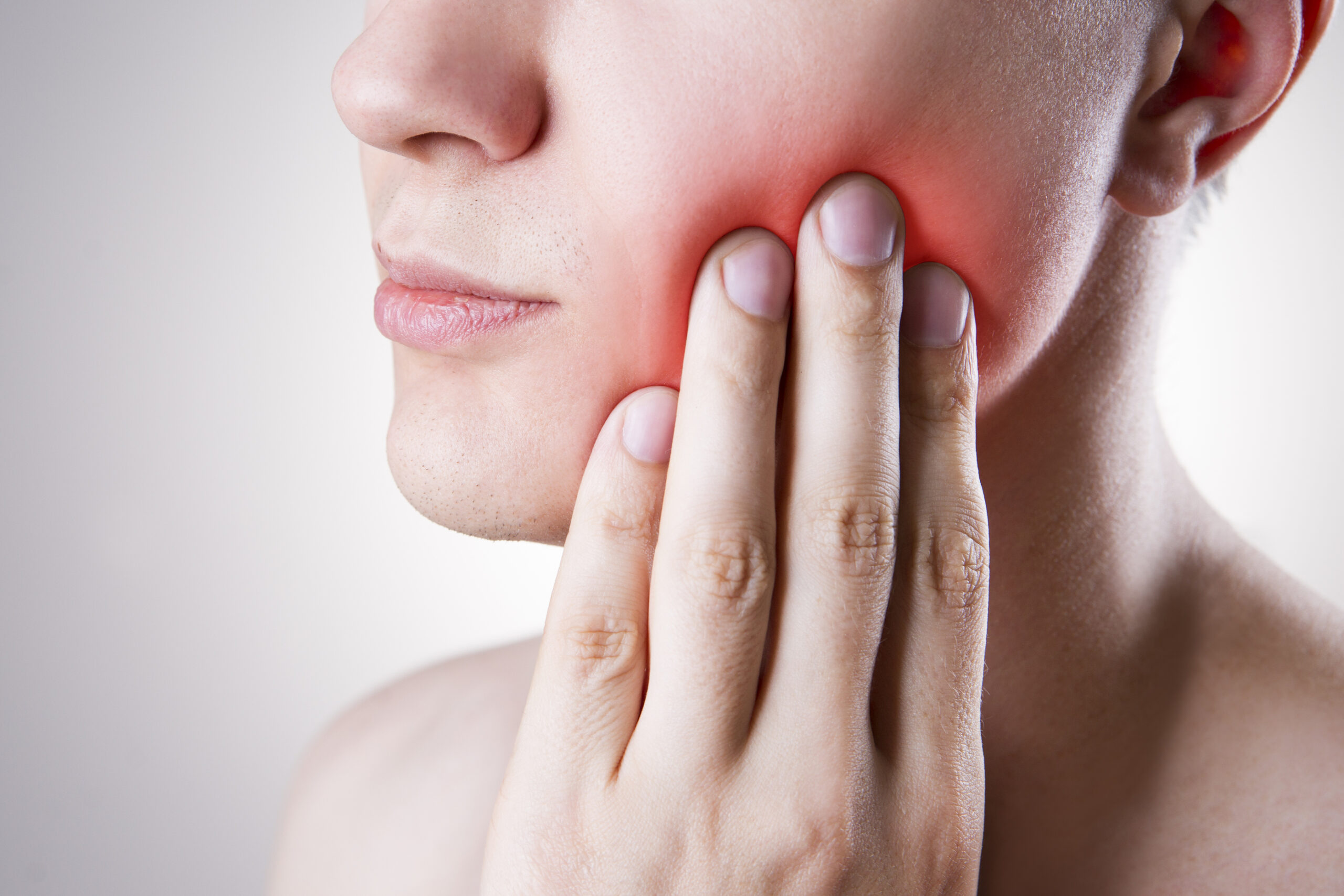A migraine headache affects up to 12 percent of the population in the United States [1].
It causes throbbing pain, usually in one area of the head, lasting a few hours to a few days [2].
The researchers believe that you can inherit migraine pain from your parents. The triggers may activate the trigeminal nerve in your head and face.
This nerve releases some chemicals (serotonin, CGRP, etc.) and neurotransmitters. Those chemicals swell up the blood vessels in your head, which causes a migraine headache. [2]
But, headache is one part of it. It usually comes with other unpleasant symptoms such as vomiting and nausea. You may also have light and sound sensitivity [3].
Scientific research and medical experiment confirm some essential oils’ effectiveness in relieving migraines and their symptoms.
This article reviews the efficacy and uses of essential oils for migraines, plus the triggers and symptoms of migraine pain.
Efficacy of Essential Oils for Headache and Migraine Relief
A migraine can last more than 3-4 days. It’s natural to grab painkiller tablets whenever you get migraine pain. But these over-the-counter drugs consist of aspirin and acetaminophen. [32]
These chemical ingredients have adverse consequences on your health in the long run. So it’s time you chose a natural remedy for migraines and headaches using essential oils.
Essential or volatile oils are the essence of various plants. They come from the plant’s leaves, fruits, flowers, barks, stems, and roots. We can get those oils by the steam distillation process.
Essential oils are necessary ingredients in aromatherapy, cosmetics, and perfumes. These oils are also vital in the medical industry. [33]
Essential oils are well known for their anti-inflammatory, antioxidant, analgesic, and antidepressant properties.
These components can soothe the pain and reduce the stress level. Thus, they bring immediate relief to your migraine and headaches. In addition, the aroma of these herbal oils can transport you to a new level of calmness and relaxation.
Read More: 12 Proven Ways to Get Rid of a Headache (with Step By Step)
Best Essential Oils for Migraines and Headaches
1. Lavender Oil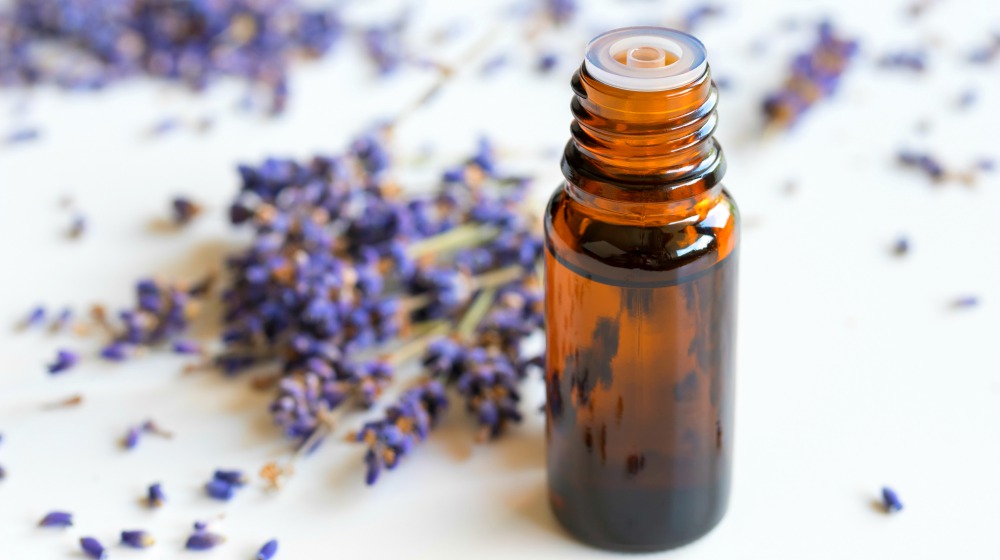
Lavender is one of the most popular herbal remedies that belong to the Lavandula genus. It’s also a famous cosmetic ingredient [4].
It treats anxiety, depression, and pain-related disorders [5].
This aromatic herb contains active compounds such as ketone and linalool. These components help tone down pain and inflammation and induce relaxation [5].
In 2012, a group of researchers from Iran assessed the effects of lavender essential oil. They did it on 47 patients suffering from migraine headaches [6].
Findings reveal that the inhalation of this oil for 15 minutes can decrease the severity of a headache [6].
Out of the 129 headache attacks, more than 90 responded well to lavender oil treatment [6].
This oil is not only helpful but also safe to use, as long as you don’t use it in undiluted form.
How to use lavender essential oil for migraine headaches:
Blend 8 drops of lavender oil, 4 drops of chamomile oil, and 1 oz. Sweet almond oil in a jar. Take a small amount. Rub it on the painful part of your head. Massage for 10 minutes. Repeat as needed.
Read More: 11 Health Benefits of Lavender Oil That You Should Know
2. Rosemary Oil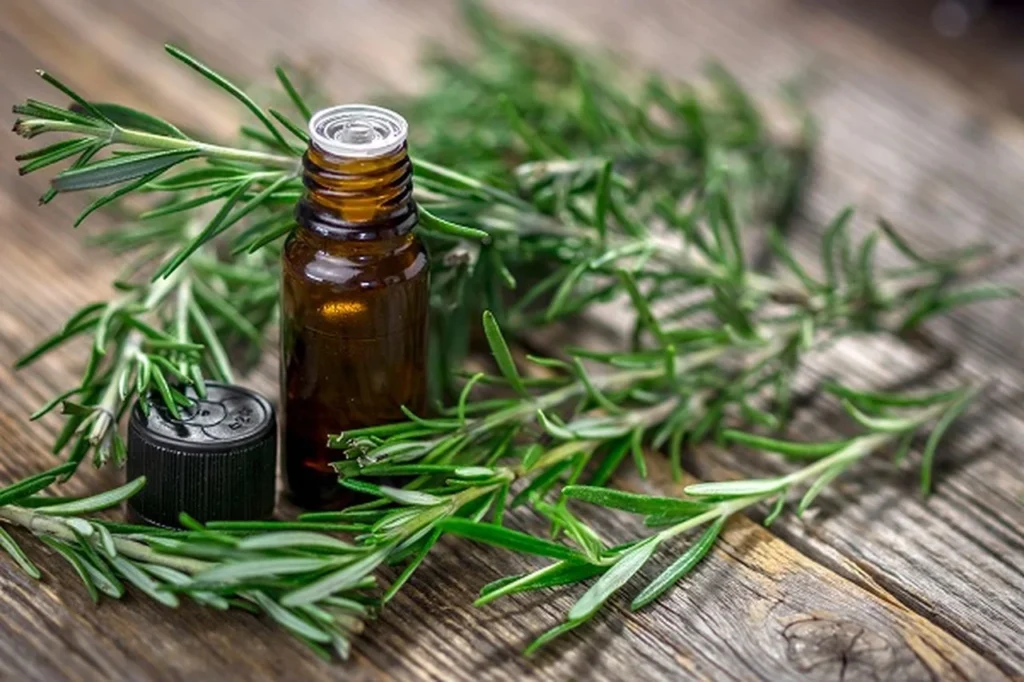
The pharmacological effects of rosemary are valuable in both traditional and modern medicine.
Rosemary oil can reduce migraine symptoms such as headache, nausea, and vomiting.
The Journal of Korean Biological Nursing Science published a study. It says aromatherapy with rosemary reduced headache and anxiety among middle-aged women [7].
You may correlate this fact with the herb’s antinociceptive and analgesic effects. Various animal experiments proved it [8, 9].
The way rosemary oil works is that it numbs the pain receptors and simultaneously blocks signals of pain in the brain.
Try this simple method of using rosemary oil for migraine:
Pour 5 drops of rosemary oil into a cotton ball. Inhale the scent. Rub the cotton ball on the temples and forehead. Repeat remedy two to three times a day until the pain subsides.
Read More: 13 Health Benefits and Uses of Rosemary Oil (Backed by Evidence)
3. Chamomile Oil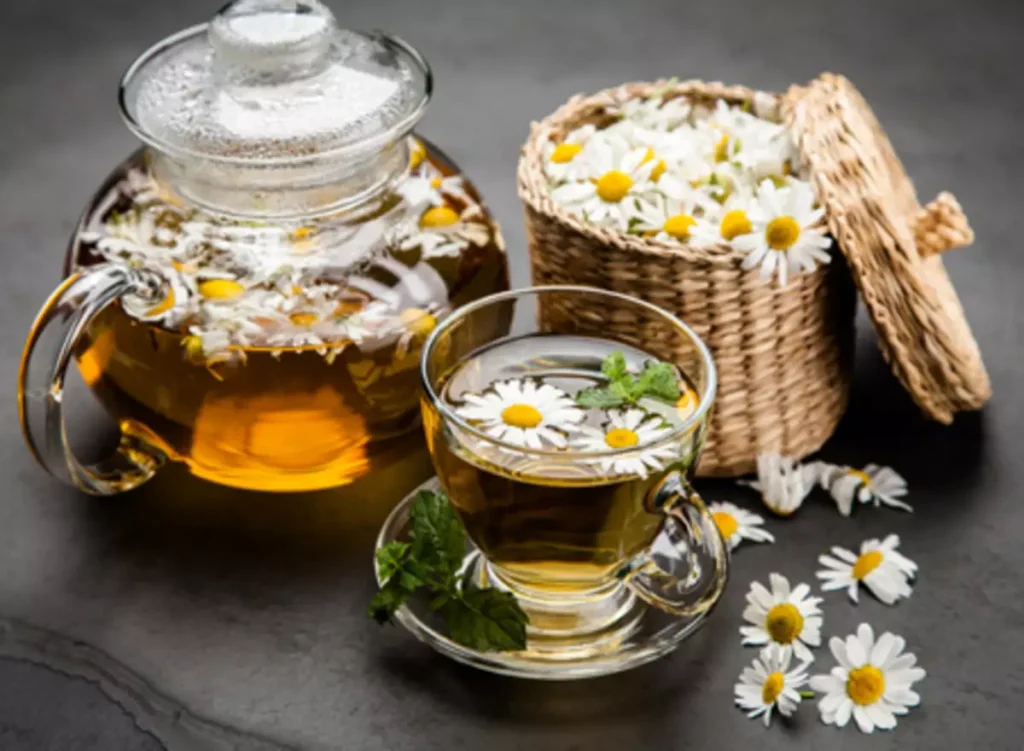
Many people enjoy drinking chamomile tea, loving its soothing effects.
Its oil extract, meanwhile, is a popular natural solution for pain and nausea.
In 2015, researchers analyzed the efficacy of chamomile as an anti-migraine treatment [10].
They discover that parthenolide and chamazulene in chamomile can inhibit migraine-related inflammation. Thus, it can prevent and treat the symptoms [10].
As you know, headache is one of the many symptoms of a migraine.
Luckily, chamomile oil can also reduce vomiting, nausea, and light sensitivity.
The topical application of chamomile oil also impedes the production of nitric oxide. It, in turn, helps reduce migraine attacks [11].
Learn how to use chamomile essential oil for headaches and migraines:
Put four drops of chamomile oil, 4 drops of helichrysum oil, and 1 oz. of jojoba oil in a glass jar. Shake to blend well. Apply a small amount to your head and scalp. Massage for a few minutes. Repeat every time you have a migraine attack.
Read More: 20 Best Essential Oils for Cold Sores Relief: Benefits and User Guides
4. Eucalyptus Oil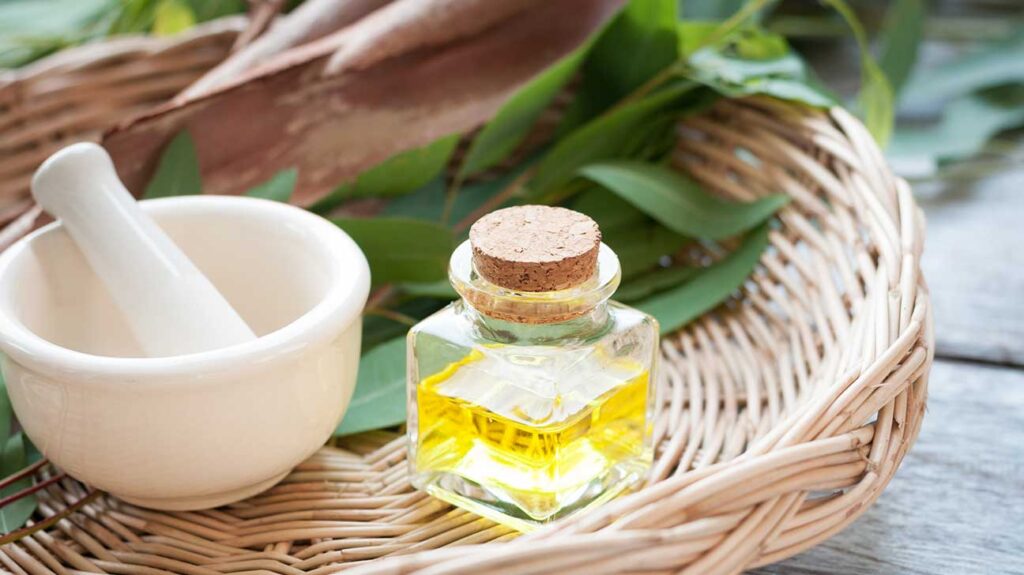
Scientists experimented with probing the effects of eucalyptus oil along with other oils. They tested on 32 individuals with migraine [12].
Results state that the oil helped with mental and muscle relaxation. It also had a positive impact on cognitive performance [12].
Researchers conducted a rat paw edema test to prove its anti-inflammatory activity [13].
It also has peripheral and central analgesic effects. These effects justify its use in folkloric medicine as a treatment for migraine [13].
It’s not hard to imagine how eucalyptus can help migraine sufferers.
After all, a quick application of eucalyptus oil on the skin leaves a feeling of coolness. Thus, it can refresh and rejuvenate your senses.
Simple use of eucalyptus oil for migraine relief:
Pour 10 drops of eucalyptus oil into a diffuser. Fill the room with its scent. Inhale deeply. Do this remedy once a day.
5. Peppermint Oil
It was in 1753 when Carolus Linnaeus first identified peppermint [14].
People considered it a species at that time, but later on, scientists discovered it was a hybrid [14].
Peppermint oil is an excellent flavoring agent used in dental and pharmaceutical products. Besides, you can use it as a natural remedy for various ailments, including migraines [14].
Menthol, the active compound in peppermint, is a known natural analgesic [15].
The International Journal of Clinical Practice featured a study. It investigates menthol’s efficacy as an “abortive treatment method” for migraine [16].
The research found that menthol in peppermint reduced symptoms of a migraine. Besides, it didn’t have any observed adverse effects [16].
Peppermint essential oil – two bottles with fresh mint leaves in the foreground.
How you can use peppermint essential oil for migraine relief:
Combine 5 drops of peppermint oil and 1 tsp of jojoba oil. Apply a thin layer to the temples and forehead. Massage using circular motions. Follow remedy each time pain triggers.
Read More: Peppermint Oil for Hair: 8 Reasons to Use
6. Helichrysum Oil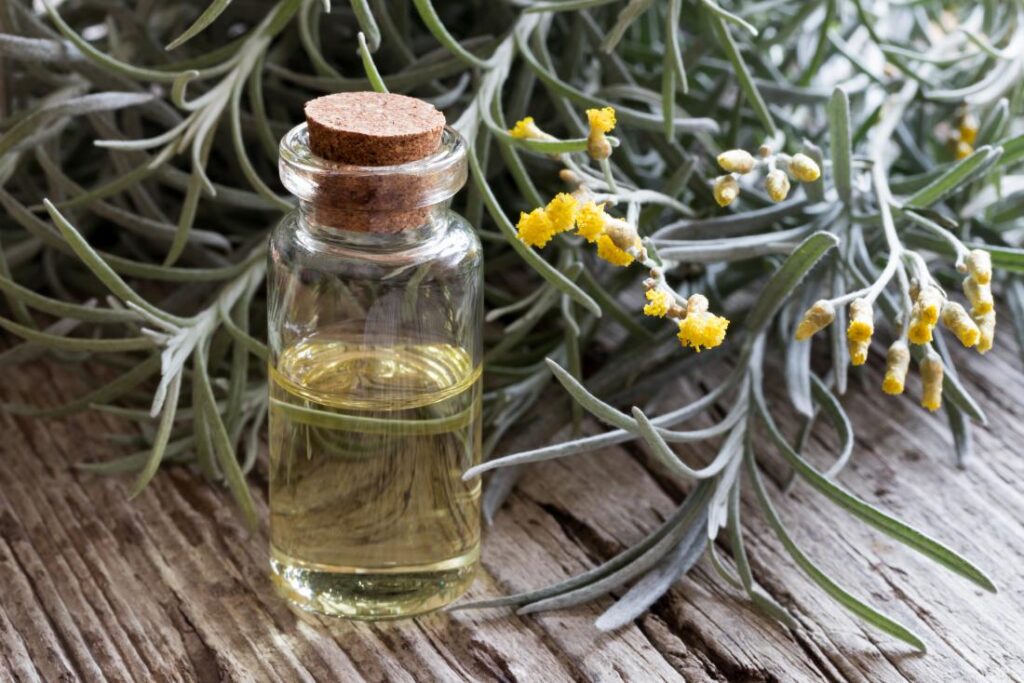
Helichrysum is quite famous in Europe, particularly in Portugal, Spain, Bosnia, and Italy. People rely on it for colds, coughs, allergies, and gallbladder disease [17].
In Turkey, it’s one of the herbal plants used to relieve a migraine [18].
Most of the studies done on helichrysum extract confirm its pharmacological effects. Those effects have a connection to its active compounds [17].
Caryophyllene oxide, for example, may contain potent anti-inflammatory and analgesic effects. These effects help tone down migraine-related pain and inflammation [19].
Because it has potent analgesic effects, you can also use it in other types of painful conditions. These are arthritis, muscular aches, stomach pain, and lower back pain.
Try this easy method to use helichrysum oil for migraine:
Mix 1 tsp of jojoba and 3 drops of helichrysum oils. Inhale the scent as you do. Massage your head. Repeat two to three times a day.
Read More: 11 Essential Oils for Back Pain to Provide Quick Relief
7. Spearmint Oil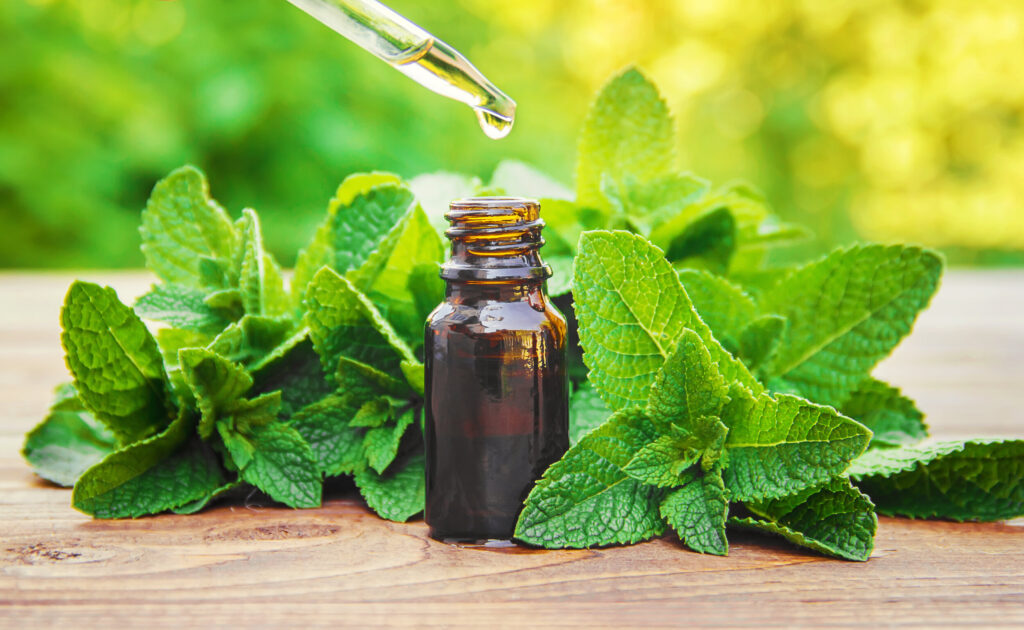
The most popular use of spearmint is for freshening up the breath and getting rid of halitosis.
Of course, that’s not all it could do.
This oil also improves the condition of those with chronic migraine attacks.
A 2013 study reports that it has analgesic and anti-inflammatory properties [20].
Its antiemetic effects can also ease other migraine symptoms like nausea & vomiting [21].
You can get quick relief from any migraine symptom you have using spearmint oil.
How to use spearmint oil for migraine remedy:
Pour 5 drops of oil into a tissue or cloth. Inhale the aroma. Do this a few times a day.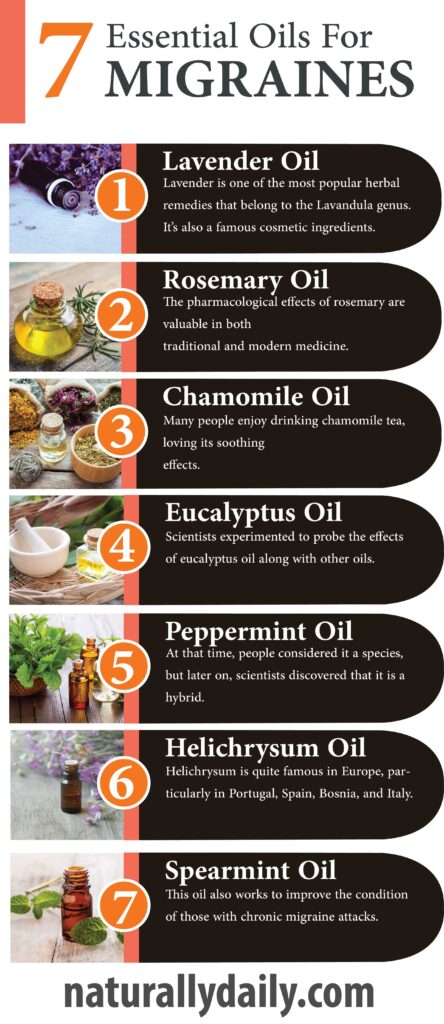
Read More: 19 Spearmint Tea Benefits for the Health You Should Know
8. Basil Oil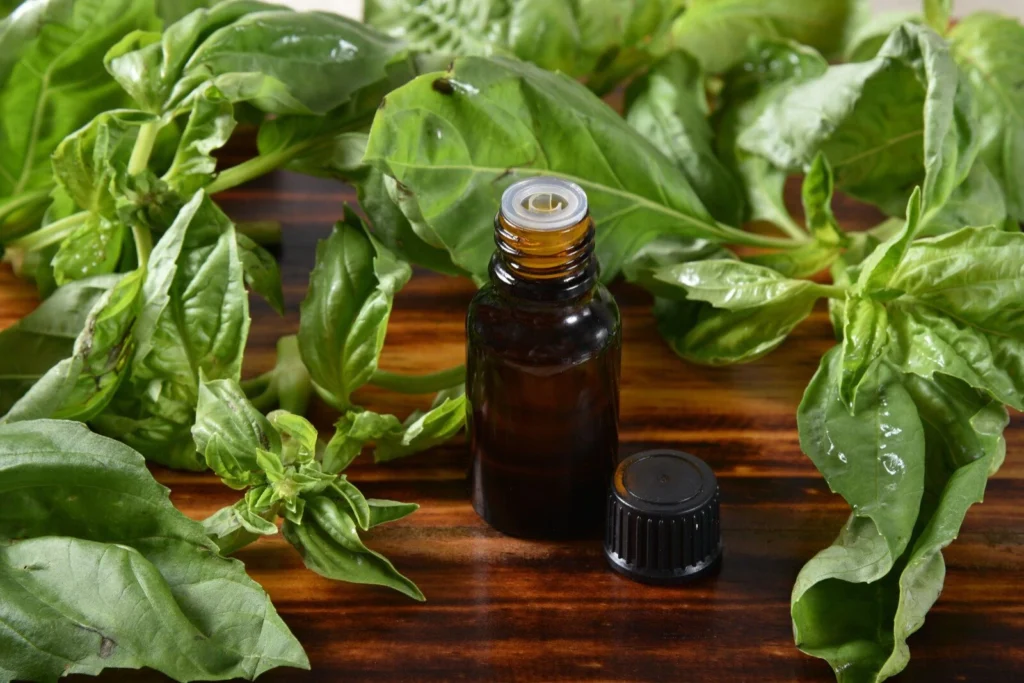
There are over 150 plant species that belong to the genus Ocimum. But basil is the most cultivated around the world [22].
Many people love its unique, enticing aroma and spicy flavor with a hint of clove and mint [22].
Besides, basil is also famous for its array of benefits for health.
Its therapeutic properties include pain relief from migraine attacks.
Clinical data shows that it is pretty effective in reducing headaches and anxiety. It means the oil can relieve those suffering from a migraine [7].
In this experiment, forty middle-aged women with recurrent cases of headaches participated. Some of them received a blend that uses basil oil as one of the ingredients [7].
They inhaled the aromatherapy blend thrice a day and applied it to the neck and shoulders daily [7].
By the time the trial was complete. The report showed that the aromatherapy blend reduced pain, stress, and anxiety [7].
How you can consume basil oil to calm migraines:
Pour 3 drops of basil oil into a cup of hot water. Drink concoction once a day.
9. Ginger Oil
Like garlic and turmeric, ginger is a root crop for many therapeutic purposes.
It is famous for pain and anxiety relief.
Ginger oil can help tone down migraine pain and dizziness and ease feelings of wanting to throw up.
Studies verified its analgesic, antinociceptive, anti-inflammatory, and antiemetic properties [23, 24, 25, 26].
Researchers compared the effects of ginger to those of metoclopramide and placebo [25].
The participants consisted of 120 women in that trial. Their pain and nausea reduced after using ginger and metoclopramide [26].
There Another study was conducted in 2005. It revealed that ginger oil reduced nausea by at least 20 percent [25].
How to use ginger essential oil for headaches and migraine:
Add 5 drops of ginger oil to a cup of hot water. Drink the mixture. Do this when you have a headache or when feeling nauseous.
Read More: 10 Health Benefits of Ginger Oil That You Should Know About
10. Rose Oil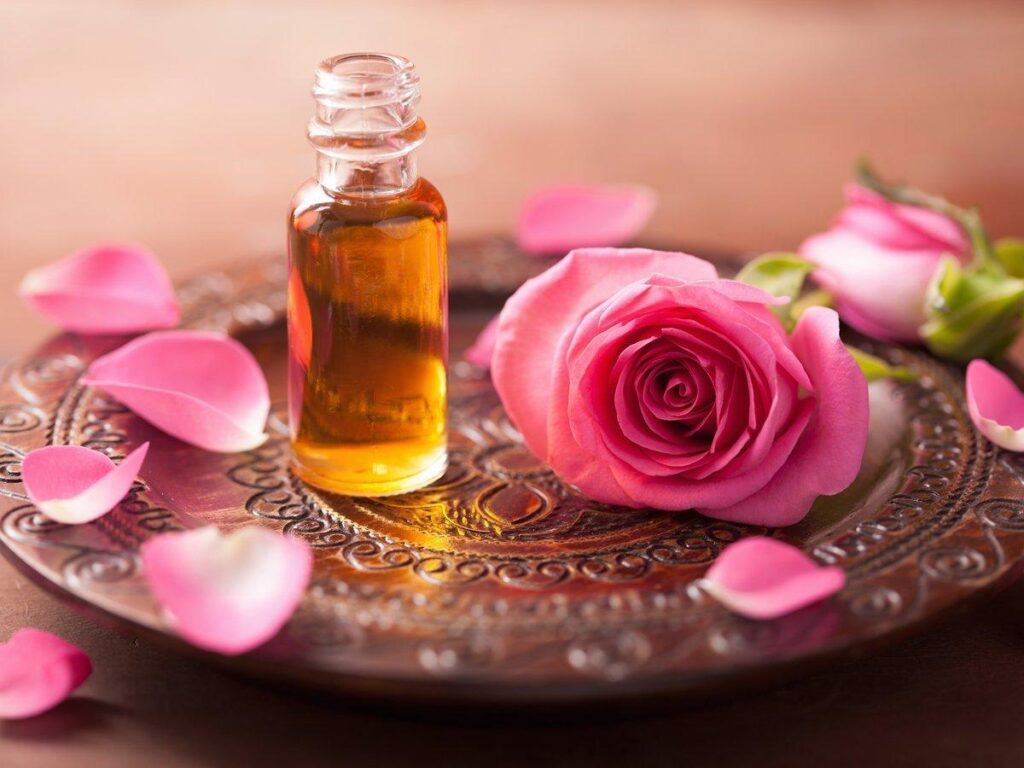
For hopeless romantics, a rose is a symbol of love.
For medical practitioners, it is a potential remedy for many types of ailments [27].
Rose oil may have significant analgesic effects. These effects can be a boon for those who have chronic cases of a migraine.
Aromatherapy with this oil can reduce headaches, pain, and anxiety from migraines [7].
This can significantly alleviate migraine symptoms, whether inhaled or applied to the skin.
The easiest way to use rose oil for migraine relief:
Put 5 drops of rose oil in a handkerchief. Then, smell the cloth whenever you feel pain.
Read More: 15 Melrose Oil Benefits and Uses You Need to Know
11. Lemon Balm Oil
Lemon balm is a famous medicinal oil. It comes from a plant native to western Asia and eastern Mediterranean regions [28].
Contributing to its significant pharmacological effects are its active compounds. These are citral, and citronellal [28].
Lemon balm oil is a potent tonic, carminative, and antispasmodic. Besides, it is a proven hypnotic and sedative agent that can do much for you if you suffer from a chronic migraine [28].
A 2008 study also confirms lemon balm oil has antinociceptive effects [29].
What this means is that this oil can disrupt pain signals in the brain, so you don’t feel as much pain as you usually do.
Lemon balm can also help induce sleep, which is why migraine sufferers can enjoy this oil.
A migraine can make it difficult for you to get a good night’s sleep.
Learn how to use lemon balm oil to soothe migraine headaches:
Put 3 drops of lemon balm oil and 1 tsp almond oil in a bowl. Transfer the oil mixture to a glass jar with a lid. Seal the cover, and shake to blend. Pour a few drops of an oil blend on your fingers. Massage your forehead and temples with your fingers. Do this for 15 minutes. Repeat remedy three times a day for one to two weeks.
12. Clove Oil
Clove oil is among the botanical medicines considered effective and safe for headaches. These include tension headaches, cluster headaches, and migraines [30].
This oil, which comes from the dried flower buds of the clove plant, can promote healing and ease pain [31].
That’s because clove oil possesses pharmacological properties. Those properties can curb pain, such as anesthetic, analgesic, and antinociceptive [31, 32].
Carvacrol, eugenol, cinnamaldehyde, and thymol are some active compounds of this oil [31].
These chemicals are responsible for their beneficial effects [31].
How to use clove oil to relieve migraine pain:
Combine 3 drops of clove and 1 tsp of coconut oil in a bowl. Put the oil blend in a glass jar. Pour a few drops of a piece of cloth. Put the fabric on top of your forehead and press. Massage the temples for a few minutes. Inhale as you do. Repeat the procedure each time you feel pain set in.
Symptoms of a Migraine
If you are down with a migraine, you’ll experience the following symptoms:
- Throbbing or pounding headache
- Vulnerable to light, loud sounds, and pungent smell
- Distorted vision
- Nausea and stomach disorders such as abdominal cramps
- Poor appetite
- Feeling tired, dizzy, and feverish. [3]
Triggers of a Migraine
Some of the triggers of activating migraine bomb include:
- Stress and anxiety
- Alcohol, food additives such as nitrates and monosodium glutamate
- Missing your regular dose of caffeine from tea or coffee
- A change of weather
- Exhaustion from work
- Exposure to hot sun for a long time
- Missing a meal
- A difference in sleeping time
Read More: 13 Essential Oils for Sinus Infection, Congestion, & Headaches
Some Tips and Lifestyle Hacks to Prevent Migraines
Have you identified what triggers your migraine pains? If you have, you can keep checking your lifestyle and avoid those migraine triggers. Below listed are some lifestyle hacks to prevent migraines.
Manage Your Stress:
Modern life is stressful. So many responsibilities and problems can leave you with stress and growing anxieties. Such a hectic life has a direct connection with your migraines issue. [34]
Take it easy. Your life is more important than your work. Be kind to yourself and find some time to relax.
You can indulge in some physical activities, light exercise, swimming, yoga, meditation, etc.
Read More: 12 Essential Oils for Stress Reduction & How to Use Them
Drink Enough Water:
Dehydration is one of the primary causes of migraines. Among many other essential functions, water regulates the cortisol hormones in your body. Thus a lack of water in the body may result in fatigue, stress, and severe migraine.
Drink a lot of water daily to keep away from exhaustion and headaches. You can also have lime juice or other fresh drinks to fill the lack of liquids in your body.
Sleep Well:
You should maintain a routine sleeping pattern. For example, don’t be awake until late or have a long siesta in the afternoon. Both of these conditions can bring on a migraine attack.
The quality and quantity of your sleep have a lot to do with your migraines. Make sure that your sleeping environment is comfortable and noise free. A light and early dinner can also help you with sound sleep.
Eat Magnesium-Rich Foods:
Magnesium has a wide range of contributions to your body. It regulates the functions of muscles and nerves and promotes a healthy heart and bones. Conversely, magnesium deficiency has adverse effects on your brain’s blood vessels.
Thus, raise magnesium intake to keep away migraines. Add some magnesium-rich foods to your diet today. These are offal, pumpkin seeds, yogurt, black beans, spinach, figs, banana, etc.
Avoid Food Allergies:
Food allergies happen when your body doesn’t agree with specific food items. As a result, it creates adverse reactions or inflammations. Inflammations inside your body can give you a migraine or throbbing headache.
Identify the offending food items that trigger an allergic response and avoid them. Common allergic foods include dairy products, cereal, peanuts, etc.
Avoid MSG mixed foods:
MSG or monosodium glutamate is a food additive, especially in fast foods and soft drinks. A high level of glutamate can affect the hypothalamus region of your brain. It may cause inflammations. So, avoid consumption of such foods regularly.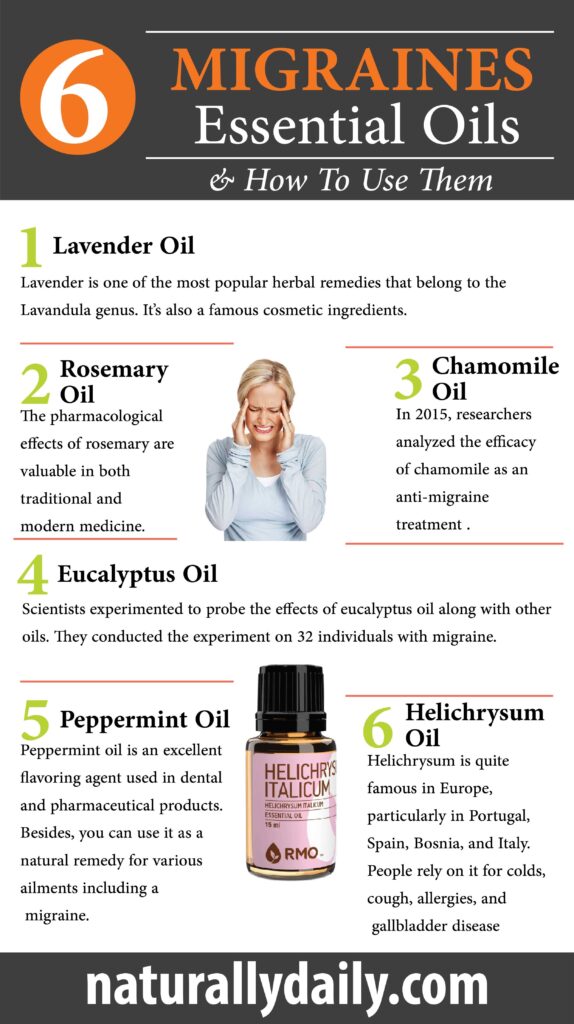
When to See a Doctor
A headache isn’t usually why you need to go to a doctor. But, when it comes to a migraine, it’s not only a headache. In addition, you may feel dizzy, have nausea, and have blurry vision.
You may also have a sudden loss of balance, numbness, and weakness which you should not take lightly. Visit your doctor and tell them about these symptoms. The doctor may prescribe you some medications based on your symptoms.
Conclusion
A pounding headache can make your life miserable. Unfortunately, it’s hard to find someone who has never suffered a migraine.
Migraine can prevent you from performing your daily tasks with efficiency. It can also make it difficult for you to enjoy life.
Migraine is one of the severe forms of headache. This pounding headache is so common these days. More than 36 million people in the USA suffer from migraines yearly. [35]
Using essential oils is a great way to cure migraine attacks at home. But, you should use these potent oils as per the recommended directions.
Read Next: 10 Home Remedies for Sinus Headaches & How to Use Them



